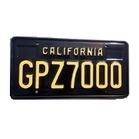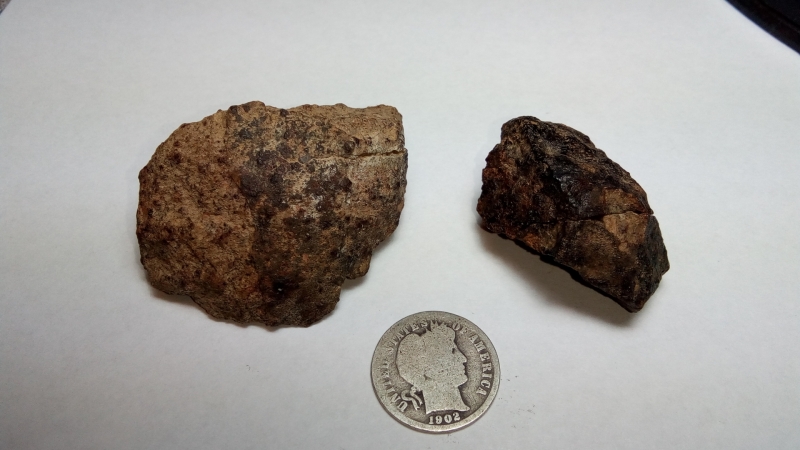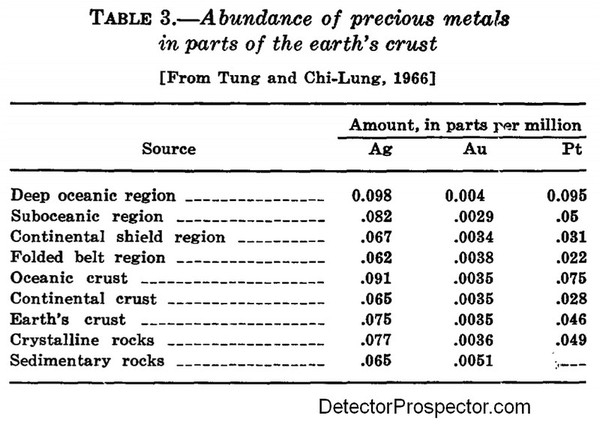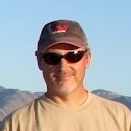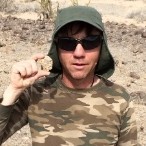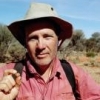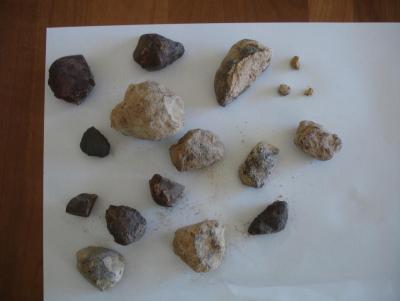Search the Community
Showing results for tags 'meteorites'.
-
I went out for a couple of days to Gold Basin seeking gold. It was not to be so when in Gold Basin you seek out some meteorites. This trip it was difficult. Nothing until the final couple of hours on Saturday night. All of my previous locations didn't produce this trip so I went to nearby locations. The larger 37g meteorite was found in an area without many dig holes. It is hard to find a location in Gold Basin without any did holes! After moving on from that location I went to an area where I could see some very old dig holes. They were deep and big and not filled but weathered down. It was time to slow down. I checked around the dig holes and voila ... a hit about 8 inches from a previous dig. Time to scrape and dig and there is a stick to rock on the magnet. (Was it part of the previous dig hole and meteorite?) Don't leave your hole in Gold Basin. Check it again. When this was done there was still a target. Upon recovery it was a broken off piece of the meteorite that was dug. They fit. Total meteorite weight is 54g.
-
Gold in Meteorites and in the Earth's Crust, U.S.G.S Circular 603 by Robert Sprague Jones, 1968 Original pdf https://pubs.usgs.gov/circ/1968/0603/report.pdf ABSTRACT The reported gold contents of meteorites range from 0.0003 to 8.74 parts per million. Gold is siderophilic, and the greatest amounts in meteorites are in the iron phases. Estimates of the gold content of the earth's crust are in the range of 0.001 to 0.006 parts per million. INTRODUCTION This report is one of several that summarize available data on the occurrence of gold. They have been prepared as background material for the Heavy Metals program of the U.S. Geological Survey, an intensified program of search for new sources of heavy metals, including gold. Data on the occurrence of gold in meteorites and tektites are summarized, and recent estimates of the abundance of gold in the earth's crust are compiled. GOLD IN METEORITES Table 1 shows reported gold contents of tektites, aerolites, siderolites, and siderites. The table is arranged so that the data on tektites, which have the lowest iron contents, are at the top of the table and the data on siderites, which have the highest iron contents, are at the bottom. The other meteorite groups are intermediate in iron contents except for the siderolites. Gold is most abundant in the siderites and least abundant in the tektites; therefore, meteorites supply good evidence of the siderophilic character of gold. The tektites and the achondrites are relatively low in gold contents and are distinct from the other groups of meteorites in this respect. The gold contents of tektites and achondrites are of the same order of magnitude as those of terrestrial rocks. The other meteorites, on the average, contain appreciably more gold. Although the iron contents of meteorites are similar in many respects to those of mafic and ultramafic rocks, the meteorites tend to contain much more gold. In chondrites, the gold seems to be almost entirely in the dispersed metallic phase (Vincent and Crocket, 1960), and this is probably true of the other meteorite. The gold content of the metallic phase of the chondrites is about 1.4 ppm (parts per million), which is similar to the gold contents of siderolites, octahedrites, and ataxites (Vincent and Crocket, 1960; Goldberg and others, 1951). The carbonaceous chondrites are primitive, relatively undifferentiated matter from which the other meteoritic types have evolved (Mason, 1962; Baedecker and Ehmann, 1965). The occurrence of gold in such primitive types may be of special interest. The average gold content for 13 carbonaceous chondrites is 0.16 ppm, an amount greater than that in the average terrestrial rock by a ratio of about 40 to 1. It has been suggested (Aller, 1961) that the best approximation to the average composition of the earth's mantle or even the entire earth is provided by the composition of the chondrites. They are similar in chemical composition to the ultramafic rocks, and their isotopic constitution for several elements is basically the same as that for the rocks of the mantle. Baedecker and Ehmann (1965) shew the abundances of gold, iridium, and platinum in four groups of chondrites. In the olivine-bronzite (H group), the olivine-hypersthene ( L group), and the carbonaceous chondrites, the abundance ratio of Pt :Ir :Au is approximately 7-9:2:1; but for the enstatite chondrites, gold is more abundant and the Pt :Ir :Au ratio is 3.5:0.2 :1. The iridium shows a relatively large decrease with respect to gold. These values, however, represent only analysis of the Abee enstatite chondrite made by Baedecker and Ehmann (1965) by neutron-activation methods. Analysis of this same meteorite by Crocket and others (1967), who also used neutron-activation methods, gives a somewhat different relationship. Their ratio for Pt :Ir :Au is 5.9 :1.5:1. The amount of platinum, iridium, and gold reported by Baedecker and Ehmann is 1.3, 0.083, and 0.37 ppm, respectively; Crocket and others reported 1.3, 0.32, and 0.22 ppm, :respectively. The iridium-gold ratio of terrestrial rocks is more like that of tektites than it is like the ratios of the other meteorites (Baedeckler and Ehmann, 1965). The gold contents of the octahedrites do nott seem to vary with the coarseness of the octahedrites. Cobb (1967) noted that most of his valules for gold in meteorites were in the range of 0.2 to 2.5 ppm. Cobb (1967) and Goldberg, Uchiyama, and Brown ( 1951) analyzed parts (three in all) of the same meteorite, and Cobb obtained lower values. The average values of gold in hexahedrites were also low compared with those of Goldberg, Uchiyama, and Brown (1951). For the same 11 meteorites analyzed by neutron-activation methods by Goldberg, Uchiyama, and Brown (1951) and Fouche and Smales (1966), the average contents were 1.1 ppm gold and 0.9 ppm gold, respectively. The various types of siderites have differing amounts of gold. Ataxites and octahedrites have an average gold content of ab1ut 1.3 ppm, which is about twice that for hexahedrites (0.64 ppm). The hexahedrites usually have less nickel than either the ataxites or the octahedrites. The Santa Catharina ataxite contained the most nickel ( 38.5 percent) and r.lso the most gold (4.0 ppm), but the Deep Springs ataxite (13.4 percent nickel) contained the least amount of gold (less than 0.1 ppm, but considered as 0.05 ppm for table 1). Fouche and Smales (1966) analyzed 70 siderites and found gold contents that ranged from 0.055 to 3.61 ppm. The correlation coefficients between gold and rhenium and between gold and chromium were low and negative, giving values of -0.41 and - 0.31, respectively, but the correlation between gold and arsenic was +0.82 and between gold and palladium +0.68. Goldschmidt and Peters (1932) analyzed the Coahuila, Mexico, meteorite and reported that it contained 1 to 5 ppm gold, whereas analysis by the neutron-activation method by Goldberg, Uchiyama, and Brown (1951) gave 0.743 ppm gold; by Fouche and Smales (1966), 0.70 ppm gold; and by Cobb (1967), 0.43 ppm gold. Goldschmidt and Peters (1932), analyzed the Mount Joy, Pa., meteorite and reported that it contained 5 to 10 ppm gold, whereas analysis by the neutron-activation method by Goldberg, Uchiyama, and Brown (1951) gave 0.994 ppm gold. These comparative values along with others in this report seem to indicate that lower values are obtained for gold when neutron-activation methods are used. ESTIMATES OF GOLD IN THE EARTH'S CRUST Parker (1967) has pointed out the difficulty in estimating the composition of the earth's crust, which forms less than 1 percent of the earth's mass (Aller, 1961). Differences among the estimates given by various authors since Clarke and Washington (1924) are due partly to different concepts of what constitutes the earth's crust, the depth to the Mohorovicic discontinuity, the composition of the oceanic crust compared with the continental crust, and the changes in crustal composition with depth. Also, with respect to gold specifically, the newer method of analysis, that of neutron activation, has resulted in a general downward revision of gold values. Table 2 gives the various estimates for the abundance of the precious metals, gold, platinum, and silver, in the earth's crust. Precious metal contents of various parts of the earth's crust has been noted by Tung and Chi-Lung ( 1966). These data are given in table 3. The estimates of gold and silver in the earth's crust have varied little since those of Clarke and Washington in 1924, although the estimates for platinum have varied substantially. The Ag :Pt :Au ratios, based on Tung and Chi-Lung's (1966) figures, are 21 :13:1. REFERENCES CITED Aller, L. H., 1961, The abundance of the elements: New York, Interscience Publishers, 283 p. Anderson, J. S., 1945, Chemistry of the earth: Royal Soc. New South Wales Jour. and Proc., v. 76, p. 329-345 . Baedecker, P. A., 1967, The distribution of gold and iridium in meteoritic and terrestrial materials: U.S. Atomic Energy Comm. [Pub.] OR0-2670-17, and Ph.D. thesis, Univ. Kentucky, 110 p . Baedecker, P. A., and Ehmann, W. D., 1965, The distribution of some noble metals in meteorites and natural materials: Geochim. et Cosmochim. Acta, v. 29, p. 329-342. Berg, Georg, 1929, Vorkommen und Geochemie der mineralischen Rohstoffe : Leipzig, 414 p. Clarke, F. W., and Washington, H. S., 1924, The composition of the earth's crust: U.S. Geol. Survey Prof. Paper 127, 117 p. Cobb, J. C., 1967, A trace-element study of iron meteorites: Jour. Geophys. Research, v. 72, no. 4, p. 1329-1341. Crocket, J. H., Keays, R. R., and Hsieh, S., 1967, Precious metal abundances in some carbonaceous and enstatite chondrites: Geochim. et Cosmochim. Acta, v. 31, p. 1615-1623. DeGrazia, A. R., and Haskin, Larry, 1964, On the gold content of rocks: Geochim. et Cosmochim. Acta, v. 28, p. 559-564. Fersman, A. E., 1933, Geokhimiya, Tom 1: Leningrad, 328 p. Fouche, K. F., and Smales, A. A., 1966, The distribution of gold and rhenium in iron meteorites: Chern. Geology, v. 1, no. 4, p. 329-339. Goldberg, Edward, Uchiyama, Aiji, and Brown, Harris~n, 1951, The distribution of nickel, cobalt, gallium, palladium, and gold in iron meteorites: Geochim. et Cosmochim. Acta, v. 2, p. 1-25. Goldschmidt, V. M., 1934, Drei Vortage uber Geochemie: Geol. Foren. Stockholm For h. v. 56 p. 385-427. ---1937, Geochemische Verteilungsgesetze der Elemente. IX. Die Mengenverhaltnisse der Elemente und der Atom-Arten: Norske Vidensk.-Akad. Oslo, Skr., Matematisk-Naturvidenskapelig Kl., 1937, no. 4, 148 p. Goldschmidt, V. M., and Peters, Cl., 1932, Zur Geochemie des Edelmetalle: Gesell. Wiss. Gottingen, Nachr., Math.-Phys. Kl., no. 4, p. 377-401. Hey, M. H., 1966, Catalogue of meteorites: British Mus. (Nat. History) Pub. 464, 637 p. Mason, Brian, 1952, Principles of geochemistry: New York, John Wiley and Sons, 276 p. ---1958, Principles of geochemistry [2d ed.] : New York, John Wiley and Sons, 310 p. ---1962, Meteorites: New York, Joln Wiley and Sons, 274 p. Noddack, Ida, and Noddack, Walter, 1930, Die Haufigkeit der chemischen Elementen: Naturw., v. 18, p. 757-764. Parker, R. L., 1967, Composition of the earth's crust: U.S. Geol. Survey Prof. Paper 440-D, 19 p. Polanski, Antoni, 1948, A new essay of evaluation of the chemical composition of the earth: Soc. Amis Sci. et Lettres Poznan Bull., Ser. B., v. 9, p. 25-46. Rankama, Kalervo, and Sahama, Th. G., 1950, Geochemistry: Chicago, Univ. Chicago Press, 912 p. Schneiderhohn, Hans, 1934, Die Ausnutzungsmoglichkeiten der deutschen Erlagerstatter : Metallwirtschaft 13, p. 151-157. Shcherbakov, Yu. G., and Perezhogin, G. A., 1964, Geochemistry of gold: Geochemistry Internat., no. 3, p. 489-496. Tung, Li, and Chi-Lung, Yio, 1966, The abundance of chemical elements in the earth's crust and its major tectonic units: Scientia Sinica, v. 15, no. 2, p. 258-272. Vincent, E. A., and Crocket, J. H., 1960, Studies in the geochemistry of gold. II. The gold content of some basic and ultrabasic rocks and sto:-1e meteorites: Geochim. et Cosmochim. Acta, v. 18, p. 143-148. Vinogradov, A. P., 1956, Regularity of distribution of chemical elements in the earth's crust: Geokhimiya, translation, no. 1, p. 1-43. ---1962, Average content of chemical elements in the principal types of igneous rocks of the earth's crust: Geokhimiya, translation, no. 7, p. 641-664.
-
Got out Saturday for a day hunt at Gold Basin, Arizona. Ended up with 3 Gold Nuggets, and a few meteorites, wish the weather stayed like this all the time ..... Dave.
- 13 replies
-
- 12
-

-
- arizona
- minelab gpz 7000
-
(and 2 more)
Tagged with:
-
If anyone is interested, here are 21 books on meteorites in pdf Download link Dave
-
Detected (gpz) this with my buddy Dave and couple of weeks back. It's tiny I know but looks possible. I tried to get some good macro shots. Chris
-
Here is a video about an 8 lb main mass Gold Basin meteorite. I've seen other large pieces found on that side before it became a monument.
-
I got out for 3 days to Gold Basin. The first day was a skunk but then at the end of the second a little color. I got up at daylight on Saturday and found a couple of meteorites before 8 AM. Then on a long walkabout I found a mini-patch of 3 pieces. Later on a 5 mile walk I found a 15g sunbaker meteorite. It is nice to get even small results with the 7000/14. Mitchel
-
There's not a lot of activity on the meteorite forum, so I thought I'd start a new thread to hopefully jump-start things. It's an invitation for forum members to post pics and/or stories of theirs or others meteorite finds. When I'm not hunting gold, I'm chasing meteorites. There's nothing quite like finding a rock that is literally out of this world. For meteorites that I have had classified, I've included links to their entries in the Meteoritical Society's catalog of officially recognized meteorites. They are cold finds; for those not familiar with the terminology, a cold find is newly discovered meteorite that is not part of any known fall or strewn field. So enjoy, and lets see some meteorites! https://www.lpi.usra.edu/meteor/metbull.php?sea=Diablo+Pass&sfor=names&ants=&falls=&valids=&stype=contains&lrec=50&map=ge&browse=&country=All&srt=name&categ=All&mblist=All&rect=&phot=&snew=0&pnt=Normal table&code=35516 https://www.lpi.usra.edu/meteor/metbull.php?sea=Quartzsite&sfor=names&ants=&falls=&valids=&stype=contains&lrec=50&map=ge&browse=&country=All&srt=name&categ=All&mblist=All&rect=&phot=&snew=0&pnt=Normal table&code=35634 https://www.lpi.usra.edu/meteor/metbull.php?sea=Imlay&sfor=names&ants=&falls=&valids=&stype=contains&lrec=50&map=ge&browse=&country=All&srt=name&categ=All&mblist=All&rect=&phot=&snew=0&pnt=Normal table&code=52855 I'll have more to share later...
-
Well... thats a bit on the ewwwww side.. i have to admit the very first tektite i had found while in W.A was on a white quartz hill, as i was zig zagging between the trees and low bushes, there was this longish black looking interesting object....i didn't know what it was.. my first thought was.. ok.. hmmmm, no other dark rocks or stones about., i reckon this is from a kangaroo.. so i stood on it! Nope still in one piece.. so I stood on it and twisted my foot, pressed down hard as i could. took my foot away, and it was still there, i thought wow!!! it sure has been baked hard in the sun.. it won't squash down to all mushy and green like kangaroo poop should.. so i than though ok.. i am intrigued now.. so bent down and picked it up.. gee its heavier than kangaroo poop.. ( yes i know what the feel and weight of kangaroo poop is lol ) and NO i have never put it in my mouth.. ewwwww .. lol never seen a rock like this before it was black. My first Tektite
-
The Minelab GPZ 7000 is an excellent meteorite detector. At the Franconia strewn field, the three small fragments shown below were "bread crumbs" that led me upslope to their larger parent individual; all were buried beneath the surface.
-
https://weather.com/science/space/video/meteor-blazes-in-illinois-sky
-

760 Pound Meteorite Found In Texas
Steve Herschbach posted a topic in Metal Detecting For Meteorites
"A large meteorite, named Clarendon (c), was discovered by a local Texas resident, by accident on April 6, 2015. At first, it appeared as a boulder, immersed in the sandy soil, but the experts soon classified it as a stony meteorite. This is the biggest individual meteorite found in Texas, and likely the second largest individual chondrite meteorite ever discovered in the US. The piece was sold to the Texas Christian University, where it's now on public display." Read the rest of the article at https://watchers.news/2016/11/08/huge-meteorite-texas-clarendon/ -
"Ancient collisions in the solar system’s asteroid belt - not space rocks passing near our planet - are the source of many meteorites found on Earth, according to new research." "Most meteorites that fall today are H and L type ordinary chondrites, yet the main belt asteroids best positioned to deliver meteorites are LL chondrites. This suggests that the current meteorite flux is dominated by fragments from recent asteroid breakup events and therefore is not representative over longer (100-Myr) timescales." https://www.nytimes.com/2017/01/23/science/ancient-bits-of-rock-help-solve-an-asteroid-mystery.html http://www.nature.com/articles/s41550-016-0035
-
Steve mentioned a desire to broaden the forum horizons. So, with that in mind here are a few pic's of some of the meteorites I found. 1.Some stuff from Holbrook found by sight-there is only one in the mix. 2. a gold basin laying entirely exposed found with detector 3. my first and only Oz meteorite found hunting gold-still in Oz at Bathurst Observatory fred
-
I've been out a few times now with the 19" and finally got over a couple of keepers! Yesterday I was hunting in a known meteorite area in Gold Basin, Arizona. Meteorites in this area are primarily surface targets to maybe 1 or 2 inches. You can still hunt in some areas for them without a detector. I started out with the 14" coil and found the 25g meteorite on the right. Now that I had located an area still holding them (and showing dig holes) I wanted to try the 19" coil. I didn't have to walk very far away before I got the 18g meteorite on the left. My first keeper of any kind with the 19" coil. Today we went a few miles away from where we found the meteorite and got the little .45g nugget that was 'missed' in a patch where I found several with the 14" coil. It was about 4" down. When I saw it and gave it a 'Find Point' I thought it was .2g. The sound was very faint but when I got to pinpointing it screamed. I was using JP's conservative settings. Before we went to Gold Basin we were in Quartzsite where I have very little experience with big gold at any depth. Actually I have very little experience anywhere with big deep gold so I'm trying to remember stories I have heard from others and go to those locations but I'll have to research more. It's just good to break in the coil. Mitchel
-
I went to Gold basin for a few days. Since I got the GPZ I had not been skunked on a trip. Some days were goldless but the GPZ always found something on each trip. That was not to be this time. I did find 6 little gb meteorites for some consolation....I wandered into some areas unknown to me but did not find any new areas. So, I returned to an area where I have found lots of meteorites and a few bits of gold. Things are getting less and none are growing back...oh, well, maybe the next time. here are some pics
-
I actually saw my first ever Perseid meteor last night on the way home from work at 12: 30 am. For 14 years, it has always been too cloudy to see anything. I only saw one, but it was a fireball. Caught a glimpse of a bright object at the top edge of my windshield, looked closer and saw a bright white ball of fire with a white tail arc over my car. I had the car window down this time, but heard no sonic booms.....5th one I have seen in last 5 years now..Wonder if a dashboard camera would catch these events? The first one I ever saw was on the Interstate coming home from an Indiana Gold prospecting trip. I thought it was a low flying airplane until I looked closer, again at the top edge of my windshield, and saw it was a Green ball of light with a short green tail, like the size of the sun. It freaked me out so bad I had to sit in a gas station for 1/2 hour to calm down. Dunno why the first fireball was green in color and the other 4 were white ?
-
My son had his first official hunt today on some private property in New Mexico. He was looking for old coins with the whites sst I gave him earlier this year, no coins but he dug this 9 1/2 ounce possible meteorite about 10 inches down. My son said a two pound confirmed meteorite was found very nearby fairly recently that looks exactly the same. My son said the detector just screamed when the coil went over it.
-
Well, thanks to the GPZ and Roger D I had a fairly successful trip to Bill's Outing at Gold basin...This is my 6th trip with the 7000 and I have found gold every trip...I hope this never ends!!! The rock to the left of the gold fooled me until I cleaned it up...it is the best Wrong I never wanted to find. fred
-
I went out to the Franconia meteorite strewn field last Friday. It is an area I know pretty good and I know a fair bit about the types of meteorites you can find there. One of the major types of meteorites is what they call an iron. It is a small meteorite that was blown by winds to their present location after a main mass burst in the atmosphere. They landed away from the main strewn field. Prior to the 8th of May I had never gotten more than 3 irons in a trip with various detectors and coils which includes a GPX 5000. Many thousands of these meteorites have been found over the years by hundreds of hunters. When you detect them the larger ones can scream at you. They are never very deep. This was a good and different trip. I had a Zed. I found 25 of the irons and a couple of larger meteorites. The largest iron at the top of the circle is .8 grams. It ends up with a tiny meteorite that I can't weigh. The total of all irons is 4.1 grams. The two larger meteorites are 46.7 grams and 114.4 grams. They were found in the same area with a depth of less then 5 inches. The Zed had no problem distinguishing them from the hot rocks. Now, bring on the gold fields!
-
I am hesitant to broach this subject. Please donot take this as my expert opinion as I am not in any way an expert. Also, I am not very good at remembering every setting I tried with the Z. So with those disclaimers...... When I was in Gold Basin for my maiden Z voyage the schiest-y rock there were abit of a problem. They were always really difficult with a vlf. I learned to trust my 3500 and 5000 when the distinct warble came through. However, the Gpz is completely new to me. Inititially I tried the default settings and thought the tracking system would quickly eliminate the HR's...that didnot work well. Then i set up with Doc's settings he posted on Rob's forum. (thank you, Doc)...that seemed better for noise but the Hrs still came through. Then I decided to try my old system for judging if the signal was an hr or a legitimate target. While in auto-track I would raise the coil a few inches; if the signal completely faded away I was sure it was an HR. However, some of the bigger and/or deeper Hrs still gave a "good" signal so I would dig...just a another Hot love-stone. There are a lot of these rocks in Gold basin so i was not thrilled. After a while I setup the user button so I could go from tracking to manual/fixed...checking in manual the HR seemed less hot and using the fast-tracking they would usually track out quickly. Just to be sure I tested with my little test nugget near the hr...the nugget always came through albeit with a different signal...more testing and experience is needed. The few iron-stone type hotrocks I detected were handled better by switching some of the modes...again more experience is needed but a similar result seemed to be had using the raise the coil or manual tracking/fast track option...I will be going to The dale area next week to see how the tons of ironstone is handled there. And to practice until perfect-that could be a very long time. One of the meteorites I detected I was fairly sure was ironstone but it would not track out...and it looked a little different...on filing an edge it proved to be a chrondrite...so even small meteorites will probably not track out-that is good news to me. On my way home I spent an hour or so in the Potholes area on a field of basalt that has/had a little gold. I thought the basalt was handled pretty easy in HY/Diffcult and auto track...I used Russ' setting there mostly...the detector ran well but no gold. I have much to learn so any tips or techniques for improving in hotrock infested areas will be appreciated... fred
-
my buddy jeff and I went up to Gold Basin for a few days...The Basin has never been generous with me or Jeff but we scapped out some gold and meteorites. This was the first time Jeff has ever bested me in quanity of meteorites and in their size. He also found the first little nuggy...we are not rich but had a fine time! I will attempt some pic's First is mine second is me proving I need to lose weight except I disappeared three is jeff's fred
-
Thanks again Steve, you are definitely speeding up my learning curve. I live in Nevada now so it will probably be a few weeks before I can get back to the beach (my wife travels to California often and has a free companion pass so I tag along for free). I will share anything new I learn. Most of my experience has been with the Fisher GB2 on meteorites and while not related to beach hunting I have learned a few tips recently that have paid off. I usually hunt the Franconia Strewn field which consists of chondrites and tiny irons. Most of the chondrites have been found and most folks think the irons have as well. But many of the irons are tiny, some smaller than 0.1 gram. The irons exist in an area that has been more or less entirely gridded. I recently bought a 14" coil for my GB2 to allow me to cover more area and went back to Franconia a few weeks ago. I hunted the usual area of "iron alley". I kept the sensitivity maxed out at 10, as well as the audio and the audio boost switch on. I ground balanced often, but with these settings the GB2 more or less is continuously noisy. Anything less than max sensitivity would be a waste of time because most hunters run maxed out. Anyway, with all the visible scrapes and dig holes on the smooth desert pavement areas I decided to instead concentrate mostly on the areas with large basalt rocks from golf ball size to around softball size. The GB2 was screaming from all the hot rocks but every now and then I could hear a slight faint blip in the background. Sure enough many of these blips turned out to be irons and many were larger than normal up to 1.5 grams or so. After 3 days of hunting I had 49 irons and 2 chondrites, a new record for me! What I learned from all of this is to focus on the specific target sound or blip that usually indicates an iron and ignore all the hot rock sounds. It can be tough to do because the basalt hot rocks create a loud background chatter that is almost continuous. And most folks avoid the basalt area for that reason. This technique probably won't be much good with the ATX because it runs so quiet, but just thought I would share it. ....jim

